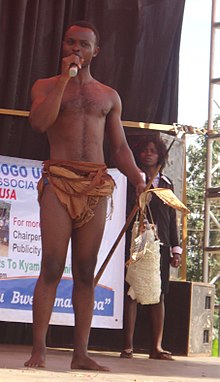The Masaba people, or Bamasaaba, are a Bantu people inhabiting the eastern Ugandan districts of Sironko, Manafwa, Bududa, Mbale, Namisindwa and Bulambuli. They are closely related to the Bukusu and Luhya of Western Kenya. They are mainly agricultural people, farming coffee, millet, bananas and sorghum on small-holder plots. Maize became popular with the coming of Europeans in the late 1890s.
 1st generation of Bamasaba culture[improve caption] | |
| Total population | |
|---|---|
| 2,300,000[1] | |
| Regions with significant populations | |
| 2,234,000[2] | |
| 66,000 | |
| Languages | |
| Masaba language, English language | |
| Religion | |
| Christianity, Traditional faith | |
| Related ethnic groups | |
| Luhya people and other Great lakes Bantu peoples | |
The name Bamasaaba is sometimes used interchangeably with the name Bagisu, even though the latter is actually a tribe of the Bamasaaba nation.
The current Babukusu of western Kenya are believed to have migrated from the Bamasaaba, particularly from areas around Bubulo, in current Manafwa District. Many clans among the Babukusu have their origins among the Bamasaaba, a testimony to this linkage. Masinde Muliro, once a veteran politician and elder of the Babukusu from Kitale, was from the Bakokho clan, with its base at Sirilwa, near Bumbo in Uganda. Other clans common to both sides include Babambo, Baata, Bakitanga and Batiiru. There are other clans whose names, however, that are only on one side, such as Babichache and Balonja who are mainly among the Babukusu. The common cultural ties are a further indication of close relations among the two sister ethnic groups. During the Constituent Assembly that led to the 1995 Constitution of Uganda, Mulongo Simon, a Delegate from Bubulo East, introduced Babukusu as one of the ethnic groupings of Uganda, acknowledging the fact that both groups, Bamasaaba and Babukusu are intertwined.